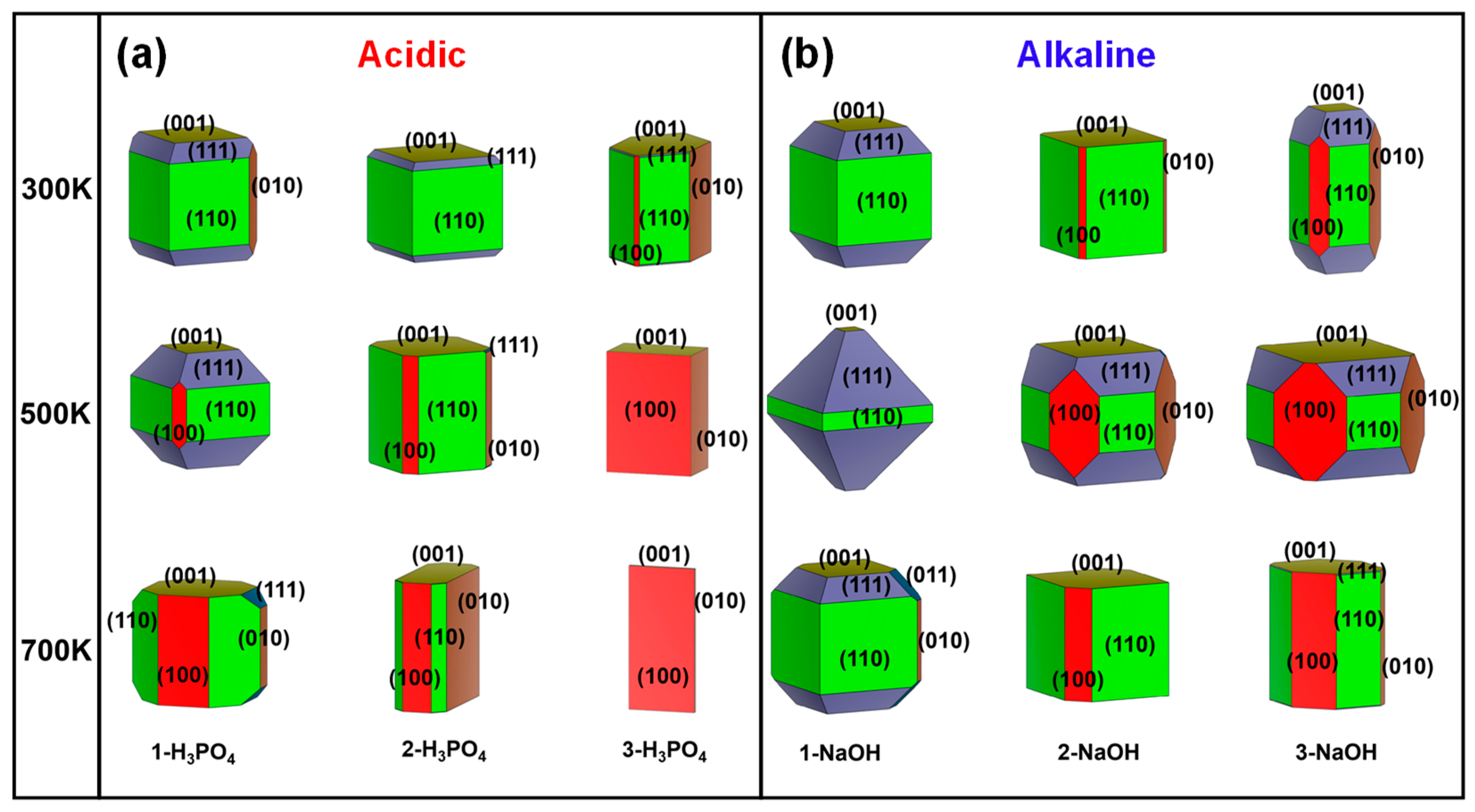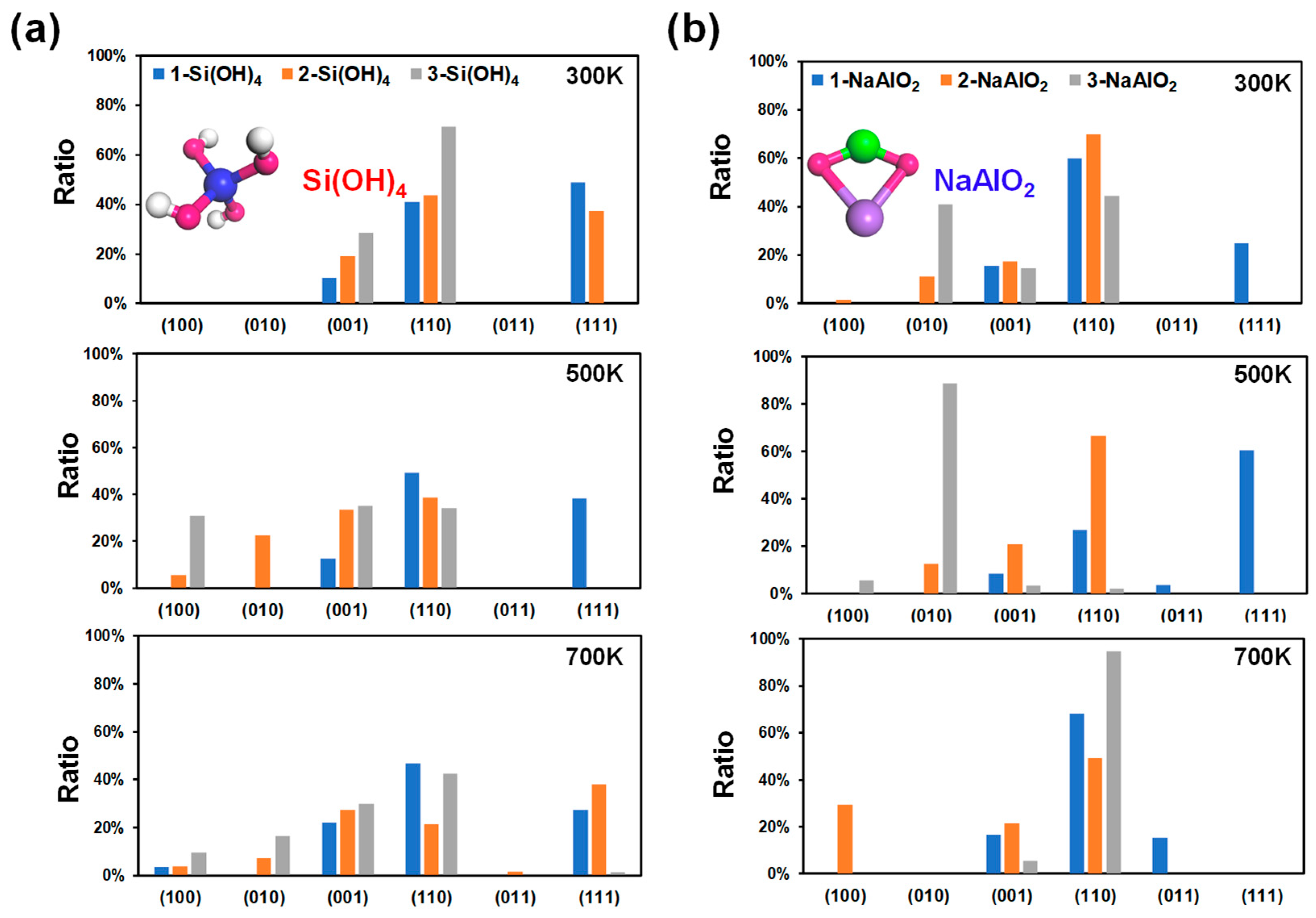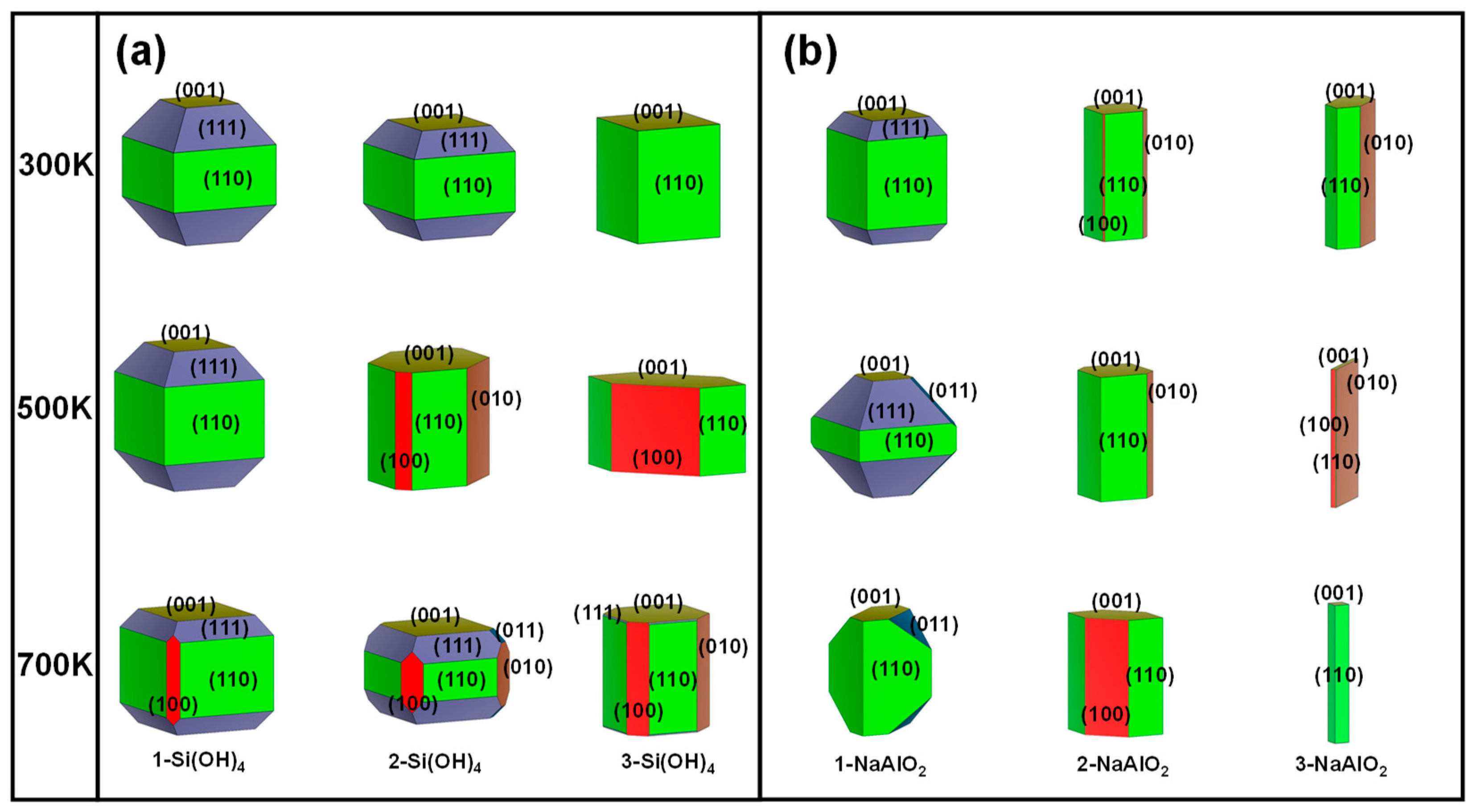Wulff Constructions for an Equilibrium MFI-Type Zeolite Shape Modelling under Different Conditions
Abstract
1. Introduction
2. Methods
2.1. Surface Energy
2.2. Wulff’s Theorem
2.3. Global Neural Network (G-NN) Potential and Molecular Dynamics
2.4. Computational Model
3. Results and Discussion
3.1. Effect of Temperature
3.2. Effect of pH at Different Temperatures
3.2.1. Effect of Acidic Conditions
3.2.2. Effect of Alkaline Conditions
3.3. Effect of Si/Al Concentration at Different Temperatures
4. Conclusions
- (I)
- Simply increasing the temperature in the absence of external factors greatly reduces the ratio of the dominant (110) surface, while the (111) proportion increases significantly.
- (II)
- In a more acidic environment, the main growth plane changes from the (110) to the (010) and then to the (100) crystal plane as the temperature increases.
- (III)
- Moderate alkalinity and temperature conditions can achieve substantial growth of the (111) surface.
- (IV)
- A high Al concentration combined with a high temperature can facilitate the growth of the (110) crystal plane.
Supplementary Materials
Author Contributions
Funding
Data Availability Statement
Conflicts of Interest
References
- Corma, A. From microporous to mesoporous molecular sieve materials and their use in catalysis. Chem. Rev. 1997, 97, 2373–2420. [Google Scholar] [CrossRef] [PubMed]
- Jacobs, P.; Flanigen, E.M.; Jansen, J.; van Bekkum, H. Introduction to Zeolite Science and Practice; Elsevier: Amsterdam, The Netherlands, 2001. [Google Scholar]
- Xu, R.; Pang, W.; Yu, J.; Huo, Q.; Chen, J.; van Santen, R.; Neurock, M. Chemistry of Zeolites and Related Porous Materials; Wiley: Singapore, 2007. [Google Scholar]
- Chen, L.-H.; Li, X.-Y.; Rooke, J.C.; Zhang, Y.-H.; Yang, X.-Y.; Tang, Y.; Xiao, F.-S.; Su, B.-L. Hierarchically structured zeolites: Synthesis, mass transport properties and applications. J. Mater. Chem. 2012, 22, 17381–17403. [Google Scholar] [CrossRef]
- Sugi, Y.; Kubota, Y.; Komura, K.; Sugiyama, N.; Hayashi, M.; Kim, J.-H.; Seo, G. Shape-selective alkylation and related reactions of mononuclear aromatic hydrocarbons over H-ZSM-5 zeolites modified with lanthanum and cerium oxides. Appl. Catal. A-Gen. 2006, 299, 157–166. [Google Scholar] [CrossRef]
- Schulz, H. “Coking” of zeolites during methanol conversion: Basic reactions of the MTO-, MTP-and MTG processes. Catal. Today 2010, 154, 183–194. [Google Scholar] [CrossRef]
- Zhu, Q.; Kondo, J.N.; Setoyama, T.; Yamaguchi, M.; Domen, K.; Tatsumi, T. Activation of hydrocarbons on acidic zeolites: Superior selectivity of methylation of ethene with methanol to propene on weakly acidic catalysts. Chem. Commun. 2008, 5164–5166. [Google Scholar] [CrossRef]
- Hartmann, M. Hierarchical zeolites: A proven strategy to combine shape selectivity with efficient mass transport. Angew. Chem. Int. Ed. 2004, 43, 5880–5882. [Google Scholar] [CrossRef] [PubMed]
- Nie, X.; Janik, M.J.; Guo, X.; Song, C. Shape-selective methylation of 2-methylnaphthalene with methanol over H-ZSM-5 zeolite: A computational study. J. Phys. Chem. C 2012, 116, 4071–4082. [Google Scholar] [CrossRef]
- Dai, C.; Zhang, A.; Liu, M.; Guo, X.; Song, C. Hollow ZSM-5 with Silicon-Rich Surface, Double Shells, and Functionalized Interior with Metallic Nanoparticles and Carbon Nanotubes. Adv. Funct. Mater. 2015, 25, 7479–7487. [Google Scholar] [CrossRef]
- Tuel, A.; Farrusseng, D. Hollow zeolite single crystals: Synthesis routes and functionalization methods. Small Methods 2018, 2, 1800197. [Google Scholar] [CrossRef]
- Fodor, D.; Pacosová, L.; Krumeich, F.; van Bokhoven, J.A. Facile synthesis of nano-sized hollow single crystal zeolites under mild conditions. Chem. Commun. 2014, 50, 76–78. [Google Scholar] [CrossRef]
- Fu, T.; Qi, R.; Wang, X.; Wan, W.; Li, Z. Facile synthesis of nano-sized hollow ZSM-5 zeolites with rich mesopores in shell. Micropor. Mesopor. Mat. 2017, 250, 43–46. [Google Scholar] [CrossRef]
- Zhang, Y.; Lu, P.; Yuan, Y.; Xu, L.; Guo, H.; Zhang, X.; Xu, L. One pot synthesis of hierarchically macro/microporous ZSM-5 single crystals. CrystEngComm 2017, 19, 4713–4719. [Google Scholar] [CrossRef]
- Zhang, Y.; Che, S. One-Pot Synthesis and Formation Mechanism of Hollow ZSM-5. Chem. Eur. J. 2019, 25, 6196–6202. [Google Scholar] [CrossRef] [PubMed]
- Zhu, P.; Zhang, Y.; Liu, C.; Wang, J.; Zhang, Y.; Zhang, W.; Liu, H.; Zhang, X. Simple and facile one-step synthesis of bowl-like hollow ZSM-5 zeolites. CrystEngComm 2021, 23, 6892–6898. [Google Scholar] [CrossRef]
- Li, Q.; Rellán-Piñeiro, M.; Almora-Barrios, N.; Garcia-Ratés, M.; Remediakis, I.N.; López, N. Shape control in concave metal nanoparticles by etching. Nanoscale 2017, 9, 13089–13094. [Google Scholar] [CrossRef] [PubMed]
- Wang, X.; Zhang, Q.; Li, X.; Ye, J.; Li, L. Structural and electronic properties of different terminations for quartz (001) surfaces as well as water molecule adsorption on it: A first-principles study. Minerals 2018, 8, 58. [Google Scholar] [CrossRef]
- Wulff, G. Xxv. zur frage der geschwindigkeit des wachsthums und der auflösung der krystallflächen. Z. Kristallogr. Cryst. Mater. 1901, 34, 449–530. [Google Scholar] [CrossRef]
- Benson, G.; Patterson, D. Note on an analytical proof of Wulff’s theorem in three dimensions. J. Chem. Phys. 1955, 23, 670–672. [Google Scholar] [CrossRef]
- Hayami, W.; Otani, S. In Effect of surface energy on the growth of boron nanocrystals. J. Phys. Conf. Ser. 2009, 176, 012017. [Google Scholar] [CrossRef]
- Jiang, F.; Yang, L.; Zhou, D.; He, G.; Zhou, J.; Wang, F.; Chen, Z.-G. First-principles atomistic Wulff constructions for an equilibrium rutile TiO2 shape modeling. Appl. Surf. Sci. 2018, 436, 989–994. [Google Scholar] [CrossRef]
- Tian, X.; Wang, T.; Fan, L.; Wang, Y.; Lu, H.; Mu, Y. A DFT based method for calculating the surface energies of asymmetric MoP facets. Appl. Surf. Sci. 2018, 427, 357–362. [Google Scholar] [CrossRef]
- Geysermans, P.; Finocchi, F.; Goniakowski, J.; Hacquart, R.; Jupille, J. Combination of (100), (110) and (111) facets in MgO crystals shapes from dry to wet environment. Phys. Chem. Chem. Phys. 2009, 11, 2228–2233. [Google Scholar] [CrossRef]
- Seif, M.N.; Beck, M.J. Surface excess free energies and equilibrium Wulff shapes in variable chemical environments at finite temperatures. Appl. Surf. Sci. 2021, 540, 148383. [Google Scholar] [CrossRef]
- Tran, R.; Xu, Z.; Radhakrishnan, B.; Winston, D.; Sun, W.; Persson, K.A.; Ong, S.P. Surface energies of elemental crystals. Sci. Data 2016, 3, 160080. [Google Scholar] [CrossRef]
- Srinivasan, S.G.; Shivaramaiah, R.; Kent, P.R.C.; Stack, A.G.; Navrotsky, A.; Riman, R.; Anderko, A.; Bryantsev, V.S. Crystal Structures, Surface Stability, and Water Adsorption Energies of La-Bastnäsite via Density Functional Theory and Experimental Studies. J. Phys. Chem. C 2016, 120, 16767–16781. [Google Scholar] [CrossRef]
- Kang, P.-L.; Shang, C.; Liu, Z.-P. Recent implementations in LASP 3.0: Global neural network potential with multiple elements and better long-range description. Chin. J. Chem. Phys. 2021, 34, 583–590. [Google Scholar] [CrossRef]
- Shang, C.; Liu, Z.-P. LASP Global Neural Network Potential Library. Available online: http://www.lasphub.com/#/lasp/nnLibrary (accessed on 31 December 2023).
- Hoover, W.G. Canonical dynamics: Equilibrium phase-space distributions. Phys. Rev. A 1985, 31, 1695. [Google Scholar] [CrossRef]
- Zhao, Y.; Sun, J.; Yang, L.; Zhai, D.; Sun, L.; Deng, W. Umbrella sampling with machine learning potentials applied for solid phase transition of GeSbTe. Chem. Phys. Lett. 2022, 803, 139813. [Google Scholar] [CrossRef]
- Díaz, I.; Kokkoli, E.; Terasaki, O.; Tsapatsis, M. Surface Structure of Zeolite (MFI) Crystals. Chem. Mater. 2004, 16, 5226–5232. [Google Scholar] [CrossRef]
- Yuan, W.; Lin, Y.S.; Yang, W. Molecular Sieving MFI-Type Zeolite Membranes for Pervaporation Separation of Xylene Isomers. J. Am. Chem. Soc. 2004, 126, 4776–4777. [Google Scholar] [CrossRef] [PubMed]
- Agger, J.R.; Hanif, N.; Cundy, C.S.; Wade, A.P.; Dennison, S.; Rawlinson, P.A.; Anderson, M.W. Silicalite Crystal Growth Investigated by Atomic Force Microscopy. J. Am. Chem. Soc. 2003, 125, 830–839. [Google Scholar] [CrossRef] [PubMed]
- Momma, K.; Izumi, F. VESTA 3 for three-dimensional visualization of crystal, volumetric and morphology data. J. Appl. Crystallogr. 2011, 44, 1272–1276. [Google Scholar] [CrossRef]
- Liu, C.; Chen, Y.; Zhao, Y.; Lyu, S.; Wei, L.; Li, X.; Zhang, Y.; Li, J. Nano-ZSM-5-supported cobalt for the production of liquid fuel in Fischer-Tropsch synthesis: Effect of preparation method and reaction temperature. Fuel 2020, 263, 116619. [Google Scholar] [CrossRef]
- Mamedova, G.A. Influence of Temperature and Alkalescency on the Crystallization of ZSM and ZK Zeolites. Theor. Found. Chem. Eng. 2021, 55, 479–489. [Google Scholar] [CrossRef]
- Liu, Y.; Luo, Q.; Lu, H.; Wang, Z. The influencing factors of hydrothermal synthesis of ZSM-5 zeolite and its adsorption of phenol, quinoline and indole. Mater. Res. Express 2019, 6, 115540. [Google Scholar] [CrossRef]
- Silva, A.V.; Miranda, L.S.M.; Nele, M.; Louis, B.; Pereira, M.M. Insights to Achieve a Better Control of Silicon-Aluminum Ratio and ZSM-5 Zeolite Crystal Morphology through the Assistance of Biomass. Catalysts 2016, 6, 30. [Google Scholar] [CrossRef]






Disclaimer/Publisher’s Note: The statements, opinions and data contained in all publications are solely those of the individual author(s) and contributor(s) and not of MDPI and/or the editor(s). MDPI and/or the editor(s) disclaim responsibility for any injury to people or property resulting from any ideas, methods, instructions or products referred to in the content. |
© 2024 by the authors. Licensee MDPI, Basel, Switzerland. This article is an open access article distributed under the terms and conditions of the Creative Commons Attribution (CC BY) license (https://creativecommons.org/licenses/by/4.0/).
Share and Cite
Zhao, Y.; Zhang, W.; Sun, L.; Li, X.; Deng, W.; Zhang, L. Wulff Constructions for an Equilibrium MFI-Type Zeolite Shape Modelling under Different Conditions. Crystals 2024, 14, 63. https://doi.org/10.3390/cryst14010063
Zhao Y, Zhang W, Sun L, Li X, Deng W, Zhang L. Wulff Constructions for an Equilibrium MFI-Type Zeolite Shape Modelling under Different Conditions. Crystals. 2024; 14(1):63. https://doi.org/10.3390/cryst14010063
Chicago/Turabian StyleZhao, Yanliang, Wei Zhang, Lei Sun, Xiaoxian Li, Weiqiao Deng, and Liang Zhang. 2024. "Wulff Constructions for an Equilibrium MFI-Type Zeolite Shape Modelling under Different Conditions" Crystals 14, no. 1: 63. https://doi.org/10.3390/cryst14010063
APA StyleZhao, Y., Zhang, W., Sun, L., Li, X., Deng, W., & Zhang, L. (2024). Wulff Constructions for an Equilibrium MFI-Type Zeolite Shape Modelling under Different Conditions. Crystals, 14(1), 63. https://doi.org/10.3390/cryst14010063





